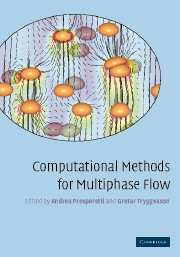Book contents
- Frontmatter
- Contents
- Preface
- Acknowledgments
- 1 Introduction: A computational approach to multiphase flow
- 2 Direct numerical simulations of finite Reynolds number flows
- 3 Immersed boundary methods for fluid interfaces
- 4 Structured grid methods for solid particles
- 5 Finite element methods for particulate flows
- 6 Lattice Boltzmann models for multiphase flows
- 7 Boundary integral methods for Stokes flows
- 8 Averaged equations for multiphase flow
- 9 Point-particle methods for disperse flows
- 10 Segregated methods for two-fluid models
- 11 Coupled methods for multifluid models
- References
- Index
Preface
Published online by Cambridge University Press: 07 December 2009
- Frontmatter
- Contents
- Preface
- Acknowledgments
- 1 Introduction: A computational approach to multiphase flow
- 2 Direct numerical simulations of finite Reynolds number flows
- 3 Immersed boundary methods for fluid interfaces
- 4 Structured grid methods for solid particles
- 5 Finite element methods for particulate flows
- 6 Lattice Boltzmann models for multiphase flows
- 7 Boundary integral methods for Stokes flows
- 8 Averaged equations for multiphase flow
- 9 Point-particle methods for disperse flows
- 10 Segregated methods for two-fluid models
- 11 Coupled methods for multifluid models
- References
- Index
Summary
Computation has made theory more relevant
This is a graduate-level textbook intended to serve as an introduction to computational approaches which have proven useful for problems arising in the broad area of multiphase flow. Each chapter contains references to the current literature and to recent developments on each specific topic, but the primary purpose of this work is to provide a solid basis on which to build both applications and research. For this reason, while the reader is expected to have had some exposure to graduate-level fluid mechanics and numerical methods, no extensive knowledge of these subjects is assumed. The treatment of each topic starts at a relatively elementary level and is developed so as to enable the reader to understand the current literature.
A large number of topics fall under the generic label of “computational multiphase flow,” ranging from fully resolved simulations based on first principles to approaches employing some sort of coarse-graining and averaged equations. The book is ideally divided into two parts reflecting this distinction. The first part (Chapters 2–5) deals with methods for the solution of the Navier-Stokes equations by finite difference and finite element methods, while the second part (Chapters 9–11) deals with various reduced descriptions, from point-particle models to two-fluid formulations and averaged equations. The two parts are separated by three more specialized chapters on the lattice Boltzmann method (Chapter 6), the boundary integral method for Stokes flow (Chapter 7), and on averaging and the formulation of averaged equation (Chapter 8).
This is a multi-author volume, but we have made an effort to unify the notation and to include cross-referencing among the different chapters.
Information
- Type
- Chapter
- Information
- Computational Methods for Multiphase Flow , pp. vii - ixPublisher: Cambridge University PressPrint publication year: 2007
